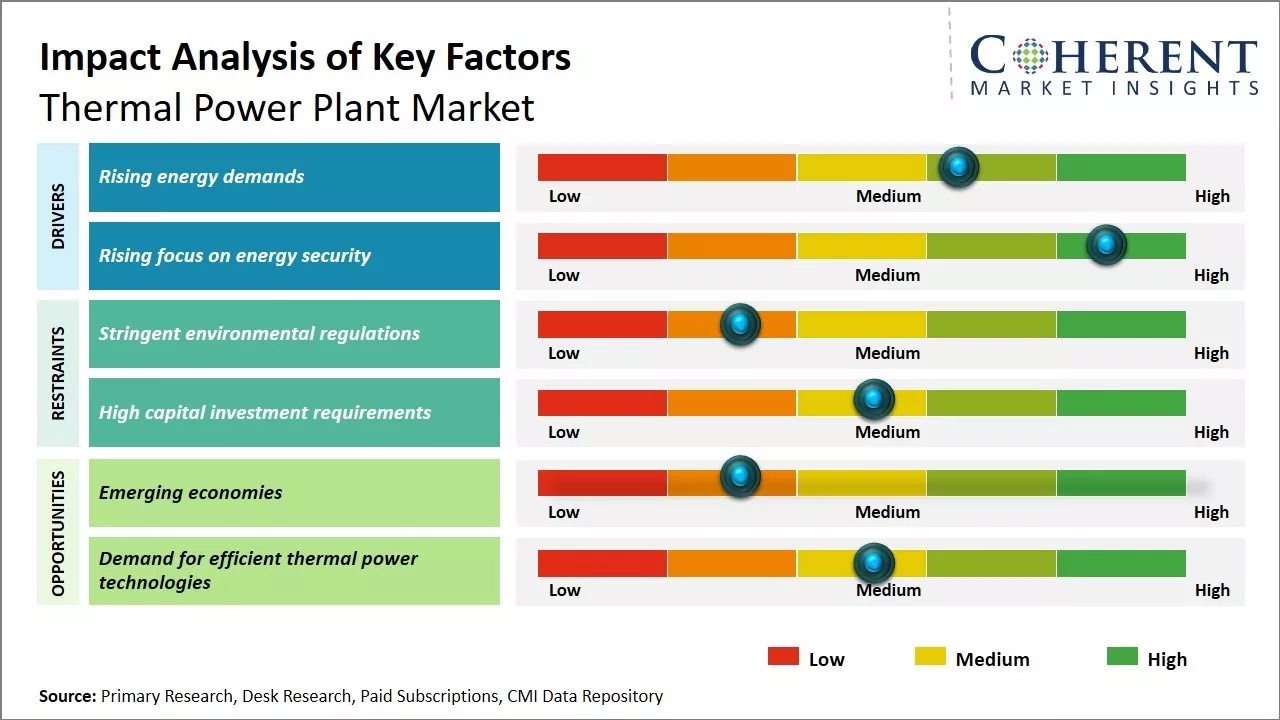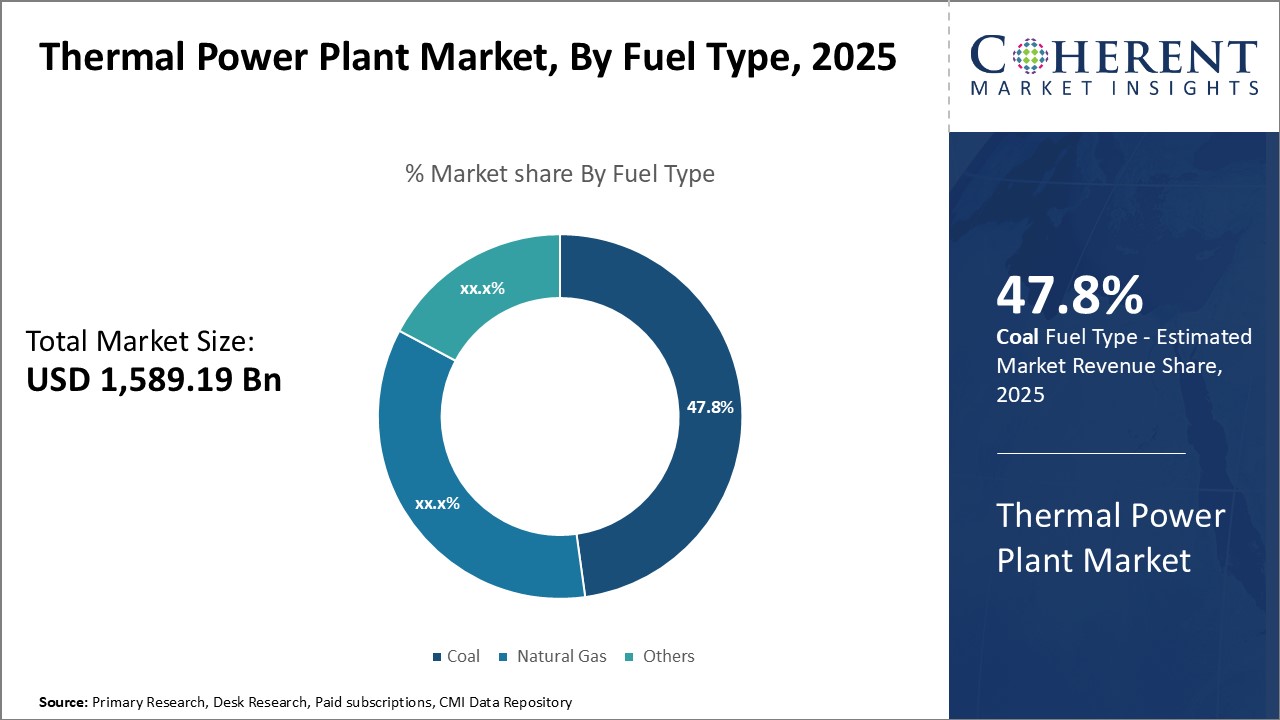Thermal Power Plant Market Size and Forecast – 2025-2032
The thermal power plant market is estimated to be valued at USD 1,589.19 Bn in 2025 and is expected to reach USD 2,050.79 Bn by 2032, growing at a compound annual growth rate (CAGR) of 3.7% from 2025 to 2032.

To learn more about this report, Download Free Sample
Key Takeaways
- On the basis of Fuel Type, the coal segment will lead the market, holding 47.8% share in 2025, owing to huge domestic reserves of coal and its affordability for base-load electricity generation.
- On the basis of Capacity, the over 800MW capacity segments will grow substantially since natural gas production continues to rise and advanced combined cycle gas plants operate efficiently.
- On the basis of Turbine Type, combined cycle turbines are expected to hold the highest market share of 42.6% in 2025, as a result of ongoing improvements in flexibility, efficiency, and performance during operation.
- On the basis of Region, North America dominates the thermal power plant market with a 42.9% share in 2025 owing to the widespread presence of major industry players and extensive refurbishment of old infrastructure, whereas Asia Pacific is the fastest-growing market, driven by enormous industrialization and urbanization.
Market Overview
Thermal power plants continue to play a pivotal role in the international energy infrastructure, particularly in new economies, as stable and economic supply of power is essential in order to provide support for urbanization and industrialization. Expanding investments on retrofitting stations for reduced emissions, transition toward natural gas-driven generation, and implementation of carbon capture and storage technologies are trends that dominate the market.
Current Events and Their Impact on The Thermal Power Plant Market
|
Current Events |
Description and its impact |
|
Geopolitical Shifts and Energy Security Prioritization |
|
|
Climate-Policy-Induced Market Bifurcation |
|
Uncover macros and micros vetted on 75+ parameters: Get instant access to report
Thermal Power Plant Market Insights, By Fuel Type: Reliable and abundant domestic reserves drive the dominance of coal
Coal represents 47.8% of the thermal power plant industry because it has stable and widespread domestic reserves in numerous nations. Coal is cheap for base-load power generation because coal's stable supply and low cost of fuel provide assurance of fuel availability over the long term at a low cost. Power companies like to utilize coal because it provides more energy self-sufficiency than using natural gas imported from abroad. Countries with high coal deposits, like China, India, and the U.S., can utilize their indigenous coal mining industry to power coal-fired power plants and meet the increasing electricity needs. Coal plants also need less infrastructure investment than natural gas plants because coal doesn't have to be piped over long distances and can be transported using existing rail and port infrastructures.
For instance, Coal India, one of the country's largest coal miner, in April 2025 planned to build a 1,600 megawatt coal power plant in Jharkhand, with the help of the state-owned Damodar Valley Corporation. The project, having an investment of around USD 1.94 billion, would add two units of 800 MW each to double the size of a current 500 MW plant. Moreover, Coal India is working on other thermal power projects, such as two 660 MW units in Madhya Pradesh and another 1,600 MW plant in Odisha, all of which are to be operational by 2030, further positively influencing the thermal power plant market share.
Thermal Power Plant Market Insights, By Capacity
:Growing natural gas resources and combined cycle efficiencies push gas capacity expansion
The capacity sector beyond 800MW has experienced increased penetration of gas-fired plants because of growing domestic shale gas production and enhanced combined cycle technology capabilities. The newly unlockable shale gas resources enable countries to boost their independence from imports while building new power plants that use gas as a fuel. Shale gas production in the United States has both increased national gas reserves while making it possible to construct several gigawatts of new combined cycle gas facilities. The operating expenses in gas power generation decreased substantially due to the high efficiency levels found in modern combined cycle gas turbines. The power produced by waste heat recovery in combined cycle plants generates sufficient efficiency to reach over 60.5% for secondary steam turbine operations. Power producers use efficiency improvements to substitute older coal plants while following the most straightforward path to lowering their emission levels per electrical output. Generous shale gas deposits and the efficiency gains from combined cycle units enable faster expansion of new, large gas power plants that surpass 800MW, further propelling the thermal power plant market share.
Additionally, the United States has experienced rapid expansion of power facilities using natural gas-fired combined-cycle (NGCC) plants for units larger than 800 MW. The U.S. Energy Information Administration revealed in January 2019 that the capacity of NGCC power plants reached 264 gigawatts and exceeded the 243 GW capacity of coal-fired plants. The efficiency levels surpass 60.5% because of combined-cycle technology enables gas turbines to produce power from waste heat for steam turbines. The United States has transitioned to a new power generation system because shale gas reserves increased both energy independence and operating efficiency levels. NGCC plants have taken over as the primary electricity generation source because of conditions like their efficiency combined with the availability of shale gas and strict pollution standards, further positively creating the thermal power plant market outlook.
Insights, By Turbine Type: Improving performance and flexibility boosts the combined cycle market share
In the turbine type configuration, combined cycle has been the most common design with continuous design development enhancing efficiency and flexibility compared to the simple cycle plants WITH 42.6%. Combined cycle operation is possible using advanced gas turbines that are highly fuel-efficient and reliable through the development of materials, cooling, and combustion controls. This allows more power output for longer operating cycles to achieve optimal asset utilization. Along with efficiency benefits, combined cycle plants can ramp up output levels more rapidly than base load coal plants to assist with smoothing out intermittent renewable energy technologies on the grid. Their flexibility enables higher solar and wind penetration with stable grid conditions. Combined cycle capacity can also be dispatched by power producers according to spot price electricity markets, consuming less fuel during off-peak demand, further positively influencing the thermal power plant market forecast.
Moreover, the growing trend of combined cycle gas turbines (CCGTs) in the thermal power generation industry is exemplified with Siemens' Flex-Plant technology. Such facilities are made to obtain quick start-up and load-following capability, thus being well-suited particularly to counteract the volatility of renewable energy output. For instance, Siemens' Flex-Plants are capable of achieving full gas turbine output in under 15 minutes and full combined cycle output within about 30 minutes with the ability to produce high efficiency over a broad span of outputs. This allows them to react fast to fluctuations in power demand and help stabilize grids as more fluctuating renewable sources are integrated into the system. These factors are thereby proliferating the thermal power plant market growth.
Regional Insights

To learn more about this report, Download Free Sample
North America Thermal Power Plant Market Trends
North America remains at the forefront of the world's thermal power plant market, commanding a large share of the market place because of its location of leading utilities and EPC companies. Texas and Florida are two major states that use fossil fuel-based power generation largely, supporting the demand in the region. In America, natural gas-fired power plant building has experienced a renaissance as a result of increasing electricity demand from industry players like data centers and artificial intelligence. For instance, NRG Energy Inc., in association with GE Vernova Inc. and Kiewit Corp., seeks to develop four natural gas electricity plants producing around 5 gigawatts of power onto the ERCOT and PJM wholesale markets of Texas. For Canada, there are natural gas-fired power plants along with investment in carbon capture and storage (CCS) facilities for existing thermal power plants with a focus to reduce greenhouse gases.
Asia Pacific Thermal Power Plant Market Trends
Thermal power equipment and services have witnessed enormous market growth across the Asia Pacific due to rapid industrialization and urbanization in countries such as China and India as well as Indonesia and Vietnam. Power suppliers within countries are not in a position to meet rising electricity demand triggered by explosive growth in demand. Power sector opening policy bringing foreign investment into country power sectors. The Indian government is going to provide permission for foreign companies to acquire up to 49% stake in Indian nuclear power plant shares as a measure of its transition to clean energy to reduce carbon emissions. Private Indian companies such as Reliance, Tata Power, Adani, and Vedanta have expressed interest in investing about $26 billion in the sector. The government plans to build 11,000 megawatts (MW) of new nuclear power generation capacity by 2040. This is further accelerating the thermal power plant market demand in Asia Pacific region.
Furthermore, Indonesia and Vietnam are also increasing their thermal power capacity. In Vietnam, coal power continues to dominate the energy mix, and investments are still being made to keep up with increasing electricity demand. In 2024, Vietnam's thermal coal imports rose by 31% to 44 million metric tons, significantly contributing to global coal import growth. Coal-fired power accounts for approximately 50% of Vietnam's electricity generation. Additionally, the 1,320-MW Vung Ang II thermal power plant in central Vietnam, with an investment of $2.4 billion, is set to connect to the national grid in December 2024. The project is backed by Japan's Mitsubishi Corporation and Chugoku Electric Power, along with South Korea's KEPCO. Regional local manufacturers are supplementing their portfolios with co-movements for high-tech technologies. There is limited import reliance on high-end parts, but initiatives are being taken to localize the value chain, offering opportunities for technology transfer and overseas companies' component manufacturing. These factors are further positively influencing the thermal power plant market forecast.
Latin America Thermal Power Plant Market Trends
In Latin America, Brazil, Argentina, and Mexico are looking towards diversifying the energy mix. Though hydroelectricity leads the way in Brazil, there has been an emerging interest in thermal plants fired with natural gas in order to safeguard energy security as well as manage peak demand. Mexico is investing in CCGT power plants by utilising its reserves and infrastructure in natural gas. Mexico is rapidly developing its combined cycle gas turbine (CCGT) plants to take advantage of its natural gas resources and infrastructure for maximizing electricity output, which is further adding to the thermal power plant market share.
The Federal Electricity Commission (CFE) has approved a series of strategic investments of billions of dollars to modernize Mexico's power generation infrastructure. The government 2025–2030 Power Generation Expansion Plan includes 12 new 5,840 MW power stations in nine states with a strong focus on CCGT projects. Five natural gas-powered plants are also planned by CFE under its 2025–2030 Generation Expansion Plan. The Salamanca, Tula, Mazatlán, Altamira, and Los Cabos plants to be constructed have been approved by the CFE Board of Directors. These initiatives are part of Mexico's broader effort to enhance grid stability and reduce carbon emissions by increasing the share of natural gas in its energy mix.
Europe Thermal Power Plant Market Trends
Europe is seeing a radical transformation in its thermal power market dynamics, moving inexorably from the use of coal-based power production to cleaner, more sustainable resources. Many leading European economies are leading this initiative, bringing the climate agenda with them in accord with their pledges under the Paris Agreement. The United Kingdom has become the first G7 nation to eliminate coal-fired electricity generation. The Ratcliffe-on-Soar power station, the country's last operating coal plant, officially ceased operations in September 2024, ending 142 years of coal-based electricity production. This historic milestone supports the UK’s ambition to generate all electricity from renewable sources by 2030.
Also, Germany’s largest power producer, RWE, announced plans to phase out coal-fired power generation by 2030, accelerating its original target by eight years. Although Germany temporarily increased lignite (brown coal) usage during the recent European energy crisis to secure electricity supply, RWE is heavily investing in renewable energy expansion to enable the coal exit. France is actively progressing toward the phase-out of coal-fired plants as well. The government has committed to shutting down the country's remaining coal power plants by 2022 while prioritizing expansion of renewable energy sources and initiatives to enhance energy efficiency. This is part of France’s broader strategy to meet its Paris Agreement obligations and transition to a low-carbon economy.
Saudi Arabia Thermal Power Plant Market Trends
The energy diversification plans of Saudi Arabia include the development of natural gas-fired power plant facilities. Siemens Energy received a $1.6 billion technology contract from March 2025 to supply both Rumah 2 and Nairyah 2 gas-fired power plants which added 3.6 GW capacity to the national grid. Operational reliability for 25 years is ensured through extended maintenance agreements which form part of the project. The kingdom planned to conduct a 2025 CCS technology-based combined cycle gas turbine power plant auction which supports Vision 2030 execution goals. This is thereby boosting the thermal power plant market revenue.
United States Thermal Power Plant Market Trends
The United States thermal power plant market is seeing growth driven by a few specific trends. One significant factor is the shift from coal to natural gas. With the rise of shale gas in the U.S., natural gas power plants have become more cost-competitive and environmentally friendly. For example, the Petra Nova project in Texas, a natural gas-fired plant, implemented carbon capture technology, showing how newer plants can help reduce emissions while providing reliable energy.
Market Report Scope
Thermal Power Plant Market Report Coverage
| Report Coverage | Details | ||
|---|---|---|---|
| Base Year: | 2024 | Market Size in 2025: | USD 1,589.19 Bn |
| Historical Data for: | 2020 To 2024 | Forecast Period: | 2025 To 2032 |
| Forecast Period 2025 to 2032 CAGR: | 3.7% | 2032 Value Projection: | USD 2,050.79 Bn |
| Geographies covered: |
|
||
| Segments covered: |
|
||
| Companies covered: |
EDF, American Electric Power Company, Inc., Siemens AG, General Electric Company, Chubu Electric Power Co. Inc., National Thermal Power Corporation Limited, ENGIE, Duke Energy Corporation, SSE, NTPC Limited, Adani Power Limited., Tata Group., Reliance Power Limited., Maharashtra State Power Generation Co. Ltd., Nuclear Power Corporation of India (NPCIL), India Power Corporation Ltd., Jindal Steel & Power Limited., and NS Energy Group |
||
| Growth Drivers: |
|
||
| Restraints & Challenges: |
|
||
Uncover macros and micros vetted on 75+ parameters: Get instant access to report
Thermal Power Plant Market Trend
Rising focus on energy security
The rising focus on energy security is emerging as a significant driver of growth in the thermal power plant market. As global energy demand continues to increase and geopolitical tensions disrupt traditional supply chains, countries are prioritizing energy independence to ensure a reliable, uninterrupted power supply. This shift is especially evident in regions like Asia-Pacific, where nations like India and China are heavily investing in large-scale coal and gas-fired power plants to diversify their energy mix and reduce dependence on imported fuels.
Thermal Power Plant Market Opportunities- Growing Emerging economies
Emerging economies continue to experience rapid industrialization and urbanization, fuelling the electricity demand growth. Thermal plants remain the most reliable solution for providing base load power needs at scale. Their modular design allows for convenient capacity expansion. The adoption of supercritical and ultra-supercritical technologies also enhances efficiency. The integration of AI and IoT can optimize plant performance.
Market Concentration and Competitive Landscape

To learn more about this report, Download Free Sample
Thermal Power Plant Industry News
- In April 2025, JSW Energy commenced the construction of its 1,600 MW (2×800 MW) ultra-supercritical thermal power plant in Salboni, West Bengal.
- In July 2024, NTPC and BHEL collaborated to set up an 800 MW AUSC thermal power plant, which will be the first of its kind using indigenously developed technology. The government has allocated ₹6,000 crore in viability gap funding to support this project.
- In March 2024, India planned to add 12 GW of new coal-based power generation capacity to meet rising electricity demand. This initiative is part of a broader goal to achieve 75 GW of thermal capacity by 2032.
- In October 2021, American Electric Power agreed to sell its Kentucky businesses, including Kentucky Power and AEP Kentucky Transco, to Liberty, a parent company of Algonquin Power & Utilities Corp's regulated utility subsidiary, for a US$ 2.84 Bn enterprise value
- In January 2021, Huaneng announced to add more than 80GW of clean energy power capacity, bringing clean energy to more than half of the company's total installed generation capacity by 2022
- In July 2022, a natural gas-fired power plant entered service in Southwest Michigan. The cost of the project was USD 1.1 Bn, and it was built by Kiewit Corporation and features equipment from General Electric.
- The Union Cabinet Committee on Economic Affairs (CCEA) approved the proposal for equity investment for two thermal power plants in India on January 18, 2024. The two plants will be set up by subsidiaries of Coal India Limited, with the aim of providing affordable electricity to the people at a reasonable cost.
Analyst Opinion (Expert Opinion)
- The thermal power plant market in Asia-Pacific is witnessing sustained growth, particularly in India and Bangladesh. The construction of large-scale coal-fired plants such as the Phulkari and Patratu projects is reinforcing regional dominance, with demand for plants exceeding 800 MW capacity continuing to rise. This trend signals that thermal power will remain the backbone of energy generation in the region for the foreseeable future, especially given Coal India’s surge in production. This provides a continued cost advantage for coal-dependent plants, effectively delaying the full transition to renewables through at least 2030.
- The adoption of Ultra-Supercritical (AUSC) technology represents a critical inflection point for the global thermal power sector. India’s push for indigenous AUSC implementation, with a 46% efficiency benchmark, is particularly noteworthy. The collaboration between BHEL and NTPC signals India's determination to not only improve energy efficiency but also to set a global standard. As other nations look to keep pace, we can expect significant R&D investments from global competitors, which will likely accelerate technology advancements.
- Simultaneously, the US and EU retrofitting programs are anticipated to create a market worth $220B+ by 2030. This market presents a significant opportunity for thermal plant operators, who will increasingly be forced to retrofit existing facilities to meet evolving emissions standards. These factors are anticipated to propel the thermal power plant market share.
Market Segmentation
- Fuel Type:
- Coal
- Natural Gas
- Others (Nuclear, etc.)
- Capacity:
- 400 MW
- 400-800 MW
- More than 800 MW
- Turbine Type:
- Simple Cycle
- Combined Cycle
- Regional:
- North America
- Europe
- Asia Pacific
- Latin America
- Middle East
- Africa
- Company Profiles:
- EDF
- American Electric Power Company, Inc.
- Siemens AG
- General Electric Company
- Chubu Electric Power Co. Inc.
- National Thermal Power Corporation Limited
- ENGIE
- Duke Energy Corporation
- SSE
- NTPC Limited
- Adani Power Limited.
- Tata Group.
- Reliance Power Limited.
- Maharashtra State Power Generation Co. Ltd.
- Nuclear Power Corporation of India (NPCIL)
- India Power Corporation Ltd.
- Jindal Steel & Power Limited.
- NS Energy Group
Sources
Primary Research Interviews from the following stakeholders:
- Power plant developers and EPC (Engineering, Procurement, Construction) contractors
- Utility operators and energy companies involved in coal, natural gas, and biomass power generation
- Technology providers specializing in carbon capture, storage (CCS), and advanced turbine systems
- Policy makers and regulatory officials from energy and environment ministries
Databases:
- International Energy Agency (IEA) Database
- U.S. Energy Information Administration (EIA) Reports
- World Bank Open Data on Electricity Generation
- BP Statistical Review of World Energy
- Global Energy Monitor (GEM) Coal and Gas Tracker
Magazines & Journals:
- Power Magazine
- Energy Policy Journal (Elsevier)
- International Journal of Greenhouse Gas Control
- Applied Energy (Elsevier)
- Journal of Energy Engineering (ASCE)
News Outlets:
- Reuters
- Bloomberg Energy
- Financial Times (Energy Section)
- The Economic Times (Energy World)
- Associated Press (AP News - Energy Section)
Associations:
- International Energy Agency (IEA)
- Global CCS Institute
- World Coal Association (WCA)
- International Renewable Energy Agency (IRENA) – for hybridization trends
- American Society of Mechanical Engineers (ASME) – Power Division
Public Domain:
- U.S. Department of Energy (DOE)
- International Renewable Energy Agency (IRENA)
- Ministry of Power (India) Reports
- United Nations Framework Convention on Climate Change (UNFCCC) Data
- Energy Charter Secretariat Reports
- ResearchGate.net – for academic papers and project case studies
Proprietary Elements:
- CMI Data Analytics Tool
- Proprietary CMI Existing Repository of Thermal Power Plant Market Data for the last 8 years
- Interviews and insights from CMI's dedicated in-house energy research team
*Definition: The thermal power plant market involves companies that generate electricity through the combustion of fossil fuels such as coal, natural gas, fuel oils, or biomass. Thermal power plants house large boiler systems that produce high-pressure steam from heated water. This steam powers turbines connected to generators that produce electricity. Key products and services in this market include coal and natural gas combustion equipment, steam generation components, turbines, generators, waste heat recovery systems, pollution control devices, and plant maintenance and control systems.
Share
Share
Missing comfort of reading report in your local language? Find your preferred language :
Transform your Strategy with Exclusive Trending Reports :
Frequently Asked Questions
EXISTING CLIENTELE
Joining thousands of companies around the world committed to making the Excellent Business Solutions.
View All Our Clients

